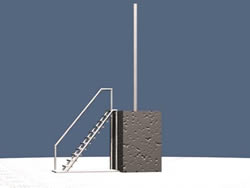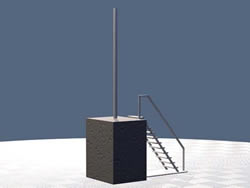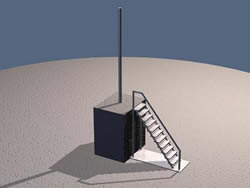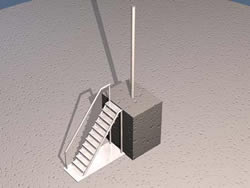Damir Nikšić
Monument to woman in transition
When speaking about the psychology of revolution it seems that every revolution puts itself in the lead of the world since it considers that it is the one that leads on the right path, while all other social orders, regimes that do not follow its innovative, progressive and revolutionary spirit and path are – decadent. For the Socialist Revolution and the Communists of the Eastern Block – the West and its rotten capitalism were the decadent ones. With this in mind, it is not strange that after decades of perceiving the West as decadent, its victory over the regimes of Eastern Europe is interpreted by many people there as the victory of decadence. Political and individual freedom is understood and interpreted as liberation from moral norms, religious, family and traditional bonds and limitations, therefore not only of the political constraints of the fallen regime. When speaking about the freedom and rights of women, dreams of liberty and liberation of women of the East from the constraints of the existing social order often assumes the elements of erotic fantasy. Medieval motive of knight and liberation of half-naked virgin from the arms of the Red Dragon of Communism is repeated in the romantic presentation of the role of West in the process of liberalization and democratization of the rest of the world. In the bourgeois and democratic society, citizen is the one who is granted the central place. It is out onto the ideological pedestal, at least in theory. However, if we set aside idealism and theory, which is the place and the role that is most often, offered in practice to women when the turmoil of testosterones of political upheavals and revolutions calm down? The fact is that the image of the woman of Eastern Europe has gone through the transitions from the de-sexualized object of exploitation in the factories and sport halls to the highly sexualized object of sexploitation in men’s magazines, strip-clubs, porn movies in which young girls from the Czech Republic, Poland, Hungary, Russia, Ukraine, Romania, Bulgaria have become the main exporting item. Trafficked young Ukrainian and Romanian girls end up even in Bosnia. It is here that they end up as prostitutes and strippers, becoming victims of violence, drug and infectious diseases. The Olympic team of the girls who had once won gold medals for the Scientific Socialism of Ceausescu’s regime, have been exploited by that ambitious regime, and are now exposed to the world public in those extremely humiliating situation of the topless gymnasts produced by a Japanese broadcaster. For many women of Eastern Europe this journey from subordination, voicelessness and from social margins, to public pedestal has in reality been the road to the nightclub stage and the aluminum pole on it. This phenomenon of sudden and uncontrolled sexual r/evolution, of sexual awakening, of the women from Eastern Europe, discovery and investigation of sexual liberties, this road of degradation and sexual objectification is deemed by some as liberalization, progress, as the manifestation of individual freedom, the freedom of choice. However, only few of them analyze seriously the reality of the situation and the extent to which these women have any choice except for the choice they would themselves consider as their last choice. Freedom is there, but the choice at offer is small and below the dignity of every woman. They are simply forced to take the road set by their exploiter who presents it to them as the only road and the only way out, as if they are cattle where the road they see as their way out is actually the one that takes them to the slaughter-house of their feminine honor and dignity. This is where the structure and dynamics of human trafficking arises from in the Western Balkans. The monument to this phenomenon, to this process in the countries in transition would be my intervention on the platforms, on the pedestals of monumental figures, statues of leaders, dictators, and other male figures that have fallen in the recent years. This intervention would include the installation of metal staircase next to the platform and of an aluminum pole on the platform itself. The aluminum pole would be the replica of the pole used on the podiums of the strippers’ clubs. Such a monument would indicate a new public place and the role of women in these societies that were until recently the closed and isolated ones. It would invite the women passers-by to make that place and that role vacant, or would appeal to the consciousness of men showing them what is the place and the role they have assigned to their sisters, mothers, daughters and female co-citizens. This construction would, therefore, be the criticism of the attitude towards women, their place and role in the countries in transition. In the context of Bosnia and Herzegovina and Sarajevo as its capital – this monument would be the criticism of BH public and BH reality. The citizens – men and women – of Bosnia and Herzegovina who have been refugees who sought and found refuge in the countries of the West, are today insensitive for the misfortune and suffering of women and girls who have ended up as trafficked in this part of the world. It is my feeling that local public and politicians take this problem as an exotic and irrelevant within our political reality, while in the same time it has become the image of our country at the international stage. It may be that this monument could be misread and taken as provocation, insult of women, and the fact that it comes from a man – may make this idea a tasteless construction of male chauvinism and as such it can be condemned and rejected. However, I am speaking about that construction: about the character and the structure of power, about the hierarchy of society characterized by the triumph of bad taste that is dictated by male chauvinism. That is why I am offering this monument – as the symbol, warning, gallows, guillotine of woman’s dignity and honor, installed on the squares of revolutions and counter-revolutions, on the venues of historical events in the recent decades.
Project received for the competition for new monument/artwork in public space in the category “Monument form – pedestal”.



